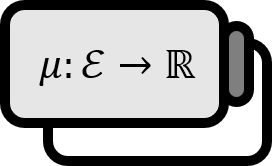Relationship between Absolutely Continuous and Integrable Functions
Buildup
Consider the following proposition.
Given a measure $\mu$ and $\mu-$ integrable function $f$ on a measurable space $(X,\mathcal{E})$, then there exists a $\nu \ll\mu$ $\nu$ depending on $f$.
It’s hardly a proof to show it. If we define $\nu$ as follows, we know that such a $\nu$ exists because it satisfies the above conditions and thus is a $\nu \ll\mu$.
$$ \nu (E):=\int_{E} f d\mu,\quad E \in \mathcal{E} $$
Explanation
Now, let’s consider the opposite situation. Suppose we are given two measures $\nu$, $\mu$ satisfying $ \nu \ll \mu$. Then, we might ask, “Does there exist an $\mu-$ integrable function $f$ that satisfies the following equation?”
$$ \begin{equation} \nu (E) = \int_{E} f d\mu \label{eq1} \end{equation} $$
The answer is ‘it does exist,’ and this is known by the Radon-Nikodym theorem. The existence of such an $f$ ensures the existence of conditional expectations in probability theory, thus the Radon-Nikodym theorem holds significant meaning.
The Radon-Nikodym theorem is generalized for signed measures in the Lebesgue-Radon-Nikodym theorem. The Radon-Nikodym theorem refers to a special case where $\lambda=0$ in the Lebesgue-Radon-Nikodym theorem. Meanwhile, $\eqref{eq1}$ can be briefly expressed as follows.
$$ d\nu=fd \mu $$
The reason for expressing it in this way is that it becomes easily understood if we integrate both sides with respect to $E \in \mathcal{E}$.
$$ \begin{align*} && \int_{E} d \nu &= \int_{E} f d\mu \\ \implies && \int_{E} d\nu &= \nu (E) = \int _{E} f d\mu \end{align*} $$
Therefore, $\lambda (E) = \nu (E) \displaystyle - \int_{E} f d\mu$ can be expressed as follows.
$$ d \lambda = d\nu -fd\mu $$
